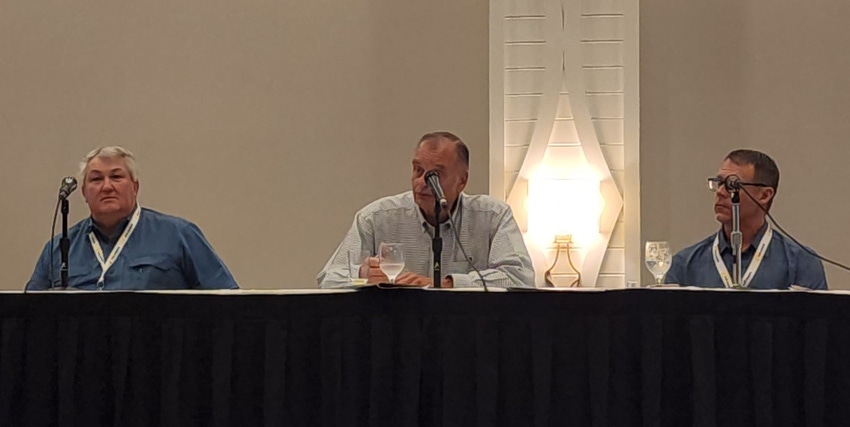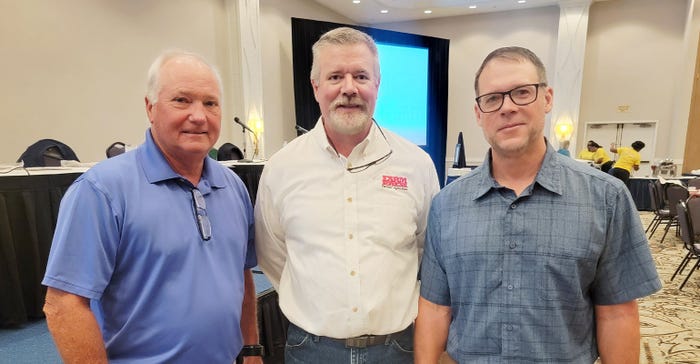
A highlight of the Peanut Efficiency Award breakfast each year at the Southern Peanut Growers Conference is the question-and-answer session facilitated by Marshall Lamb, where the Farm Press PEA winners field questions from the audience.
At this year’s breakfast held July 23 at the Edgewater Beach & Golf Resort in Panama City, Fla., 2022 PEA winners Ben Cowin for the Upper Southeast; Wayne Hobbs for the Lower Southeast; and Karl Stutzman for the Southwest discussed how they are managing increasing production costs, among other topics. Mitchell Rogers of Covington County, Miss., the winner for the Delta Region, was unable to attend the conference or breakfast.
Lamb, research leader at USDAs National Peanut Research Laboratory in Dalton, Ga., is program adviser for Peanut Efficiency Award program.
Each of the winners expressed concern about escalating production costs this year, but cautioned against cutting expenses too much. Each said achieving high yields is key to profitability.
“Every time you go get something; the price is up. I always ask myself, do I really need it. Most of the time, it’s yes. It doesn’t matter what things cost, if you don’t make a crop, you’re just out of the ball game from the beginning. I remain conscious of prices, and I try to cut every little bit I can, but there’s only so much you can cut. I still strive for the high yield because that can overcome high costs most of the time,” said Ben Cowin, of Williamston, N.C.
“You have to look at what it costs if you don’t do it. You just have to try to control inputs and try to take care of the crop as best you can,” said Wayne Hobbs of Rebecca, Ga.
“We have to be able to make a yield. It’s scary when you think about the cost. It’s more concerning to me when you skimp because it’s going to cost you next year. It will cost your yield this fall,” said Karl Stutzman of Weatherford, Okla.
The winners were asked how they evaluate new varieties and new technology on their farms.
Stutzman said he likes to pick what he wants and what works best and stick with it. He noted the Spanish variety SPAN-17 works well for him.
“We’re encouraged to grow mostly Spanish (varieties) because we have a shorter season. I like SPAN-17 because they grow on a runner type plant. For me, a runner plant harvests easier. They dig better and thresh easier,” he said.
North Carolina’s Cowin also said he likes to stick with what works. He said he always looks at the North Carolina State University variety trials when evaluating new varieties. He said he now plants all high-oleic varieties because that’s what the shellers want. Hobbs also said he likes to stay with varieties that work and has had great success with the variety GA 06-G.
Cowin, Hobbs and Stutzman were asked if there is a moment in the growing season that is the most critical time for them.
Stutzman said July is the most critical time for him. “We’re setting pegs, that’s where the crop comes from. It’s important for us to keep the plant healthy. It’s important for us to keep water there, and some years that’s harder than others, and this year it’s been really tough.”
Said Hobbs, “It’s hard for me to pin-point a certain time. To me, from start to finish. If you mess up anywhere in there, you hurt yourself.
Cowin said mid-August is the most critical time in his area of North Carolina. He said rain in mid-August is critical for good vine growth and for the peanut plant to put down pegs.
All three Peanut Efficiency Award winners said they use gypsum every year. Cown said he applies 1,400 pounds per acre. Hobbs said he applies 1,000 to 1,200 pounds per acre while Stutzman said he applies 2,000 pounds per acre.
Each of the winners stressed the importance of timely digging.
“I usually go by the vines, as long as the vines are green and healthy, and the stems are strong I’ll wait. But when it starts to be ‘getting time,’ I get kind of antsy,” Cowin said, adding that he uses the Peanut Profile Board, developed by North Carolina State University Extension Peanut Specialist David Jordan, to determine maturity.
Hobbs said he uses the hull scrape method to determine digging time. He stressed that his Extension agent, Phillip Edwards, provides great guidance in determining maturity and the right time to dig.
Stutzman said his consultant, Beck Johnson, provides guidance on the best time to dig peanuts. “I want to leave them in the ground as long as I can without having a freeze. More maturity is just better grade. Better grade means more profitability. I try to balance that risk when I can. I want them to be as mature as they can be.”

On hand for the 2022 Farm Press Peanut Efficiency Awards breakfast are from left, Marshall Lamb, research leader at USDAs National Peanut Research Laboratory in Dalton, Ga., is program adviser for Peanut Efficiency Award program; Southeast Farm Press Editor Brad Haire; and Karl Stutzman, Peanut Efficiency Award Winner for the Southwest. (Photo: Shelley Huguley)
About the Author(s)
You May Also Like






